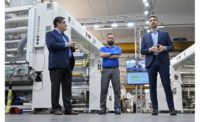Giancarlo Caimmi
Commercial Director
Nordmeccanica
18 years with the company
(631) 242-9898
www.nordmeccanica.com
Albert Chicote
Nexus Laminating & Coating Brand Manager
Comexi Group
7 years with the company
+34 972 47 77 44
www.comexigroup.com
Frank Passarelli
Product Manager, Printing, Coating & Laminating
Bobst North America Inc.
19 years with the company
(973) 226-8000
www.bobst.com
Q: What are some new developments and/or trends you’re seeing in the coating and laminating sector?
Caimmi: This is an incredibly healthy industry and trends are in continuous evolution. With the increasing strengthening of the market, converters have paid their best attention in the past quarters in productivity and quality. This is a matter of selecting the best technology for their conversion needs as it is for the need to invest in additional capacity. This has influenced the market for new machinery, as it has influenced the confirmed growth on those technologies that have been able to guarantee higher productivity and superior quality. It is about not only the selection of the proper adhesive and/or coating technology, it is a lot about the selection of the most appropriate conversion process. In fact, specifically in North America, the number of multi-ply laminators and “single pass” conversion machinery we have installed is impressive – exceeding even the most optimistic expectations. Reason is definitely in the need to speed up the time to market and to improve quality while reducing scraps. It has been about 3-ply laminators; 2-ply laminators with an in-line coting process; higher performance models; full automatic set-ups; in a few words: every solution that allowed for increased performances.
Chicote: We see a clear trend toward reducing the carbon footprint and VOC’s (volatile organic compounds). Governments with new legislations are pushing the market to print and laminate in a more sustainable way, using green technologies as much as possible. Furthermore, brand owners and converters are constantly looking for innovative packaging solutions to highlight their product on the shelf. The use of matte and gloss lacquers in register is growing in the packaging segment. Beyond that, the use of holography seems to be an emerging technology in packaging design.
Passarelli: The move in the direction of eco-friendly packaging is gaining momentum and demand. Therefore, new developments are on the rise. This includes the use of biodegradable materials which albeit still limited in use, are the subject of intense research on the part of producers of films, inks, adhesives, and resins. As converting equipment manufacturers, we must keep the pace with the new materials that are developed as their physical properties of the raw materials derived from various vegetable sources are different from those of conventional films. This has a bearing on their machinability, for both printing and also laminating. This is why Bobst has been carrying out tests and demonstrations for a number of years now. For instance, in a recent open house in Bobst Italia’s technology center, only materials derived from renewable sources were demonstrated. In this instance, two compostable films – a lacquered metallized film and a lacquered transparent film were laminated using a compostable solvent-based adhesive applied with our flexo coating system. The lamination speed achieved was slightly below the machine speed for conventional substrates, but the end results for meeting the two main requirements of coating the lowest quantity of adhesive while obtaining the best optical results for the laminated structure were remarkable.
Q: Are there any new technologies your company has in the works? If so, please elaborate.
Chicote: Comexi Group has dedicated a lot of resources to focus on the trends of sustainability and added value packaging solutions.
With regards to sustainability, Comexi Group has developed a full range of water-based solutions to complement digital narrow web and wide web machines. We have entered into a joint agreement with HP where Comexi Group produces a laminator, Comexi NEXUS L20000 that will follow their digital press. This laminator uses 100 percent water-based adhesive technology, which provides the converter with significant speed to market benefits. Our wide web solution, Comexi NEXUS ML1 WB, is capable of laminating at high speeds with unbeatable optical appearance, outstanding drying performance and high productivity.
To address the growing interest in holography, we have developed an UV holographic machine, Comexi NEXUS Futura. The NEXUS Futura produces an endless array of patterns onto a web. With this technology known as Cast & Cure, we deliver the ability for our customers to produce an unbeatable cost-effective way to apply holograms and cold-foil on packaging. Further, our NEXUS Futura runs without any kind of emissions to the atmosphere, providing another sustainable solution for our customers.
Caimmi: We are currently working on a number of new developments that will involve both coated compound formation evolution as well as machine design evolution. We have a few announcements to be released by next year at the two major show events in the world: Drupa and K-Show. As proven through the entire history of Nordmeccanica, serious innovation is not the product of one single player. Once technology hits the picks of the modern conversion industry every evolution is the result of the efforts of a superior team of experts. This is what we at Nordmeccanica are currently doing – collaborating with industry leaders to design new products and technologies. Our latest announcement, an unsurpassed register control system for coating in register on existing print is the example. Nordmeccanica and Siemens collaborated to generate the most innovative and accurate commercial system, developed in accordance to the specific needs of the coating industry. On the vacuum side of coating technology, we have also released new and innovative design solutions for our vacuum metallizers for pattern metallization and Alox coating.
Q: What role has the coating and laminating sector been playing in the sustainability realm?
Caimmi: I think a large one. While packaging in general keeps being the target of a panel of hysteric ignorant, our industry has generated the most significant innovations directed to effect sustainability. Some influence is in the technology itself. Lighter packaging, reducing the product to package weight ratio, has contributed largely to reduce emissions while allowing limiting food waste. Other influences have been generated by innovation in conversion technology. I think to the Nordmeccanica design of ovens that has allowed for faster production speeds while reducing energy consumption; I am thinking to courageous machine design choices such as our one to include as a standard regenerative drives in our machine set up. Regenerative drives, while allowing for superior performances, feature the benefit to self-generate over 15 percent of the machine energy consumption during normal production runs with the relevant associated savings.
Passarelli: Composite materials possess the physical, chemical and mechanical properties that are a result of the combination of the properties of each individual web and also, the protection and extended life of the packaged items for food, medical, or industrial application from deterioration, which successfully address sustainability.
Chicote: For quite a while now, solvent-based adhesive technology has been steadily replaced by solventless or water-based adhesives. As for lamination webs, there is a clear tendency towards reducing the gauge of films as much as possible, while maintaining functionality in terms of barrier, seal ability or stiffness. Functional coatings with certain barrier properties or sealable functions are growing as a result of this trend.
Q: Has your company been making any efforts towards practicing sustainability? If so, how?
Passarelli: The two main areas of focus of our R&D is to increase the efficiency of equipment to serve the dual purpose of reducing the impact of industrial operations, while achieving significant cost savings at the same time via reduction of waste and reduction of energy consumption.
Bobst laminators and extrusion coating plants feature the combination of two types of nozzles – impingement and floatation type – that attune the drying process and obtain maximum efficiency. The flotation-type air nozzles above and below the substrate between the rollers increases the heat exchange. The impingement-type air nozzles in correspondence of the rollers, strengthens and optimizes the impact of air on the substrate. Additionally, the air recirculation groups are sized to optimize power consumption and the tunnel hood insulation prevents heat dispersion.
Another area where the principle of sustainable technology can be successfully implemented in lamination is the adhesive metering/coating where specific technical solutions have been devised aimed at lower coating weights. A noteworthy Bobst development is the flexo coating system which is especially effective for applying the adhesive directly onto thin aluminum foil at high speed. The system is able to coat a lower solvent-based adhesive weight with comparable bond strength. By preventing the formation of “orange peel” or wrinkles, as well as foil breakage, it considerably reduces waste and the amount of residual solvent on the laminated structure.
Caimmi: All of our plants and locations, worldwide, are designed with sustainability in mind. It is not only about the production process but it is as well about building design and energy efficiency. From the Italian headquarter to the recently opened location in North America, all building related parameters and process handling protocols are informed to the most advanced energy saving, energy efficiency and emission reductions criteria.
Q: What types of film coatings do you notice your customers are requesting more of?
Chicote: With the tremendous increase of the ready-to-eat foods, salads and sliced products such as cheese or cured meats, we see a growing request for heat-seal lacquers. Antimist / antifog coatings have a considerable demand in the fresh-cut produce market as well a synthetic cold-seal in the confectionery and medical markets. As mentioned above, shelf appeal and promotions have driven the growth of registered gloss and matte lacquers, holographic images and cold-foil.
Caimmi: The trend remains the same as last year. In register coating. The matte-gloss lacquer applied in register to pre-printed rolls to enhance graphics, constitute a large part of our new installations.
On another side, the pharmaceutical sectoris growing with a lot of capacity, and therefore new orders, for machinery in the pharma-packaging (coating and lamination) as well as in the blister industry.
Q: Is there anything else you’d like to share about coating and laminating?
Caimmi: In 2014 Nordmeccanica has been confirmed as the largest manufacturer of coating and lamination machinery, with over 270 installations last year. It is a performance that awarded undoubtedly our continued efforts in quality and innovation. Talking on that ground, we can confirm that the conversion industry is an industry marked by constant growth, very healthy and very much motivated in new investment to remain competitive to the always increased expectations of brand owners. There is not a winning technology. There is instead the appropriate technology for the specific needs. It takes a good effort of cooperation between the converter and its supplier to come to a safe solution. This is what we believe is the best value we can provide to our customers.
Chicote: Packaging is a dynamic market, we continually work to establish strong partnerships with other co-suppliers and converters to develop and nurture the next packaging innovation. Our broad portfolio of solutions (flexo, gravure, offset, lamination, coating, and slitting) and our world-class Manel Xifra Boada Technological Center provides Comexi Group with an advantage and the ability to foresee and plan for tomorrow’s packaging challenges.





